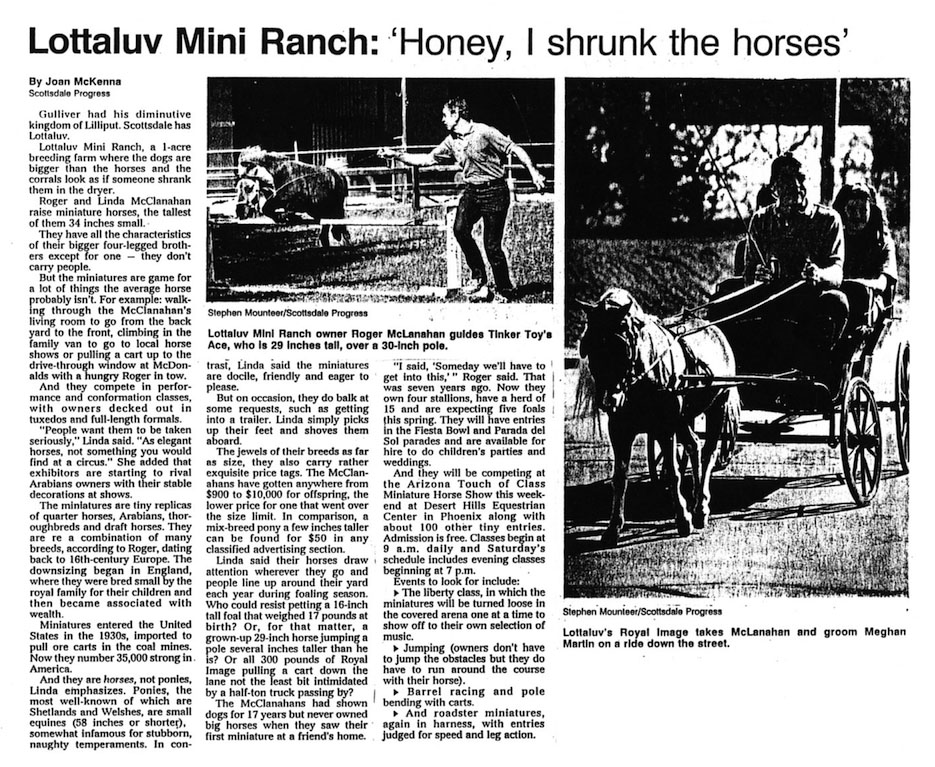Lottaluv Mini Ranch: ‘Honey, I Shrunk the Horses’
Scottsdale Progress Nov. 20, 1991Lottaluv Mini Ranch, a 1-acre breeding farm where the dogs are bigger than the horses and the corrals look as if someone shrank them in the dryer.
Roger and Linda McClanahan raise miniature horses, the tallest of them 34 inches small.
They have all the characteristics of their bigger four-legged brothers except for one — they don’t carry people.
But the miniatures are game for a lot of things the average horse probably isn’t. For example: walking through the McClanahan’s living room to go from the back yard to the front, climbing in the family van to go to local horse shows or pulling a cart up to the drive-through window at McDonald’s with a hungry Roger in tow.
And they compete in performance and conformation classes, with owners decked out in tuxedos and full-length formals.
“People want them to be taken seriously,” Linda said. “As elegant horses, not something you would find at a circus.” She added that exhibitors are starting to rival Arabians owners with their stable decorations at shows.
The miniatures are tiny replicas of quarter horses, Arabians, thoroughbreds and draft horses. They are a combination of many breeds, according to Roger, dating back to 16th-century Europe. The downsizing began in England, where they were bred small by the royal family for their children and then became associated with wealth.
Miniatures entered the United States in the 1930s, imported to pull ore carts in the coal mines. Now they number 35,000 strong in America.
And they are horses, not ponies, Linda emphasizes. Ponies, the most well-known of which are Shetlands and Welshes, are small equines (58 inches or shorter, somewhat infamous for stubborn, naughty temperaments). In contrast, Linda said the miniatures are docile, friendly and eager to please.
But on occasion, they do balk at some requests, such as getting into a trailer. Linda simply picks up their feet and shoves them aboard.
The jewels of their breeds as far as slze, they also carry rather exquisite price tags. The McClanahans have gotten anywhere from $900 to $10,000 for offspring, the lower price for one that went over the size limit. In comparison, a mix-breed pony a few inches taller can be found for $50 in any classified advertising section.
Linda said their horses draw attention wherever they go and people line up around their yard each year during foaling season. Who could resist petting a 16-inch tall foal that weighed 17 pounds at birth? Or, for that matter, a grown-up 29-inch horse jumping a pole several inches taller than he is? Or all 300 pounds of Royal Image pulling a cart down the lane, not the least bit intimidated by a half-ton truck passing by?
The McClanahans had shown dogs for 17 year but never owned big horses when they saw their first miniature at a friend’s home.
“I said, ‘Someday we’ll have to get into this,’ ” Roger said. That was seven years ago. Now they own four stallions, have a herd of 15 and are expecting five foals this spring. They will have entries in the Fiesta Bowl and Parada del Sol parades and are available for hire to do children’s parties and weddings.
And they will be competing at the Arizona Touch of Class Miniature Horse Show this weekend at Desert Hills Equestrian Center in Phoenix along with about 100 other tiny entries. Admission is free. Classes begin at 9 a.m. daily and Saturday’s schedule includes evening classes beginning at 7 p.m.
Events to look for include:
— The liberty class, in which the miniatures will be turned loose in the covered arena one at a time to show off to their own selection of music.
— Jumping (owners don’t have to jump the obstacles, but they do have to run around the course with their horse).
— Barrel racing and pole bending with carts.
— And roadster miniatures, again in harness, with entries judged for speed and leg action.
